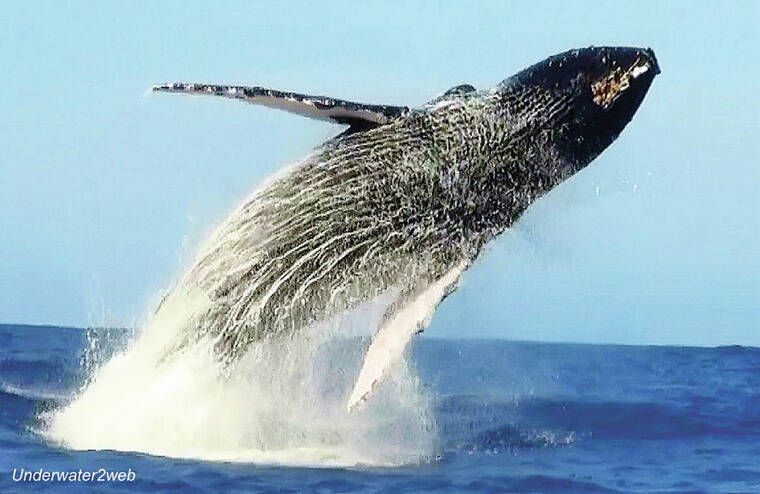Humpback whales migrate to Hawai‘i from Alaska in the fall and stay in the warm waters of Hawai‘i for several months until spring to give birth and mate. Whale watching tours are extremely popular especially in January, February and March when the whales do a lot of breaching. It is exciting to see these giant creatures launch completely out of the water and come crashing down with a big splash!
Living in Hawai‘i, I often see the humpbacks breach and occasionally get pictures and video of them launching out of the water next to my boat or kayak. But as a marine biologist, I have always wanted to know why they breach. Humpback whales seem to breach more than any other whale species and it was once thought that they breach to remove parasites from their skin. Recent studies have shown that their breaching may be for several reasons that are becoming clearer to us due to having better technology to record whale activity.
I have seen humpbacks breach many times and usually they will breach several times in a row, but I have video of a humpback near Hanalei Kaua‘i breaching 12 times in a row! I also noticed that when one whale breaches often that triggers other whales in the area to breach, and I also noticed that most of the time humpbacks breach toward the sun.
We know that male humpbacks sing underwater and those vocals can travel a great distance because sound travels over four times faster underwater then up in the air. By using very sensitive underwater listening devices, we can record a whale’s song and we also can record other whales responding to that song. It is now known that these whales can communicate with each other over great distances even across entire oceans!
When a whale breaches it is also communicating with outer whales. Notice when you see a whale breach, it turns sideways in the air to make the biggest splash when it comes crashing down. The sound it makes when it hits the water surface makes a noise that travels to other whales in the area.
The larger the whale, the larger the noise it makes when it breaches. Are the whales communicating with their spash? A female humpback may be able to tell the size and power of a male whale by the sound it makes when it breaches. Are the males showing off to attract a female for breeding? Maybe.
Why do the whales seem to breach toward the sun? They may be tracking the coastline from the air using their internal GPS. If they breach in the same direction toward the sun each time, they could be making a mental map of the coastline.
We do the same thing underwater when we scuba dive to monitor the coral reef. We go in the same direction and use GPS on consecutive dives to map out the entire coral reef. The whales may be doing the same thing to map out the coastline to see what Hawai‘i looks like from above the water’s surface.
Humpback whale singing and breaching tends to change when they are in areas of high boating and submarine activity. Large container ships and military submarines use sonar, which is very loud underwater and interferes with the whale’s communications. Just like you may need to yell at a friend if you are standing on the edge of a busy freeway, but at home in your quiet house you could whisper and be heard.
Humpback whales have been in our oceans way before humans evolved on earth, and fossil records show they even lived on land in the past. The whale’s brain is highly complex and it may be breaching for other reasons we have not even thought of yet. One way or another, it is a very special gift to to see a breach as it may be way more complex than we think.
You can see the Hawai‘i humpback whales in action in my movie called Hawaiian Marine Mammals up on my website at www.underwater2web.com. The movie also covers spinner dolphins and monk seals, and is a wonderful movie to share with the whole family and visiting friends.
•••
Terry Lilley is a marine biologist living in Hanalei Kaua‘i and co-founder of Reef Guardians Hawai‘i, a nonprofit on a mission to provide education and resources to protect the coral reef. To donate to Reef Guardians Hawaii go to www.reefguardianshawaii.org.




